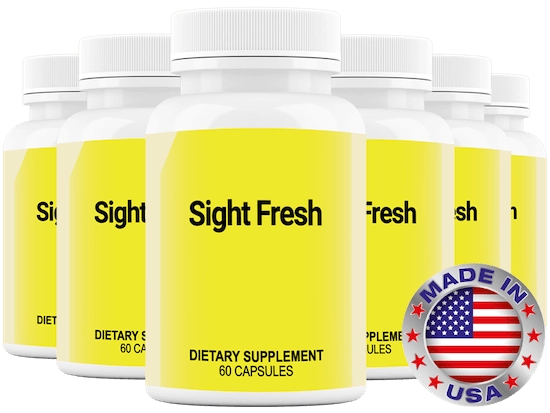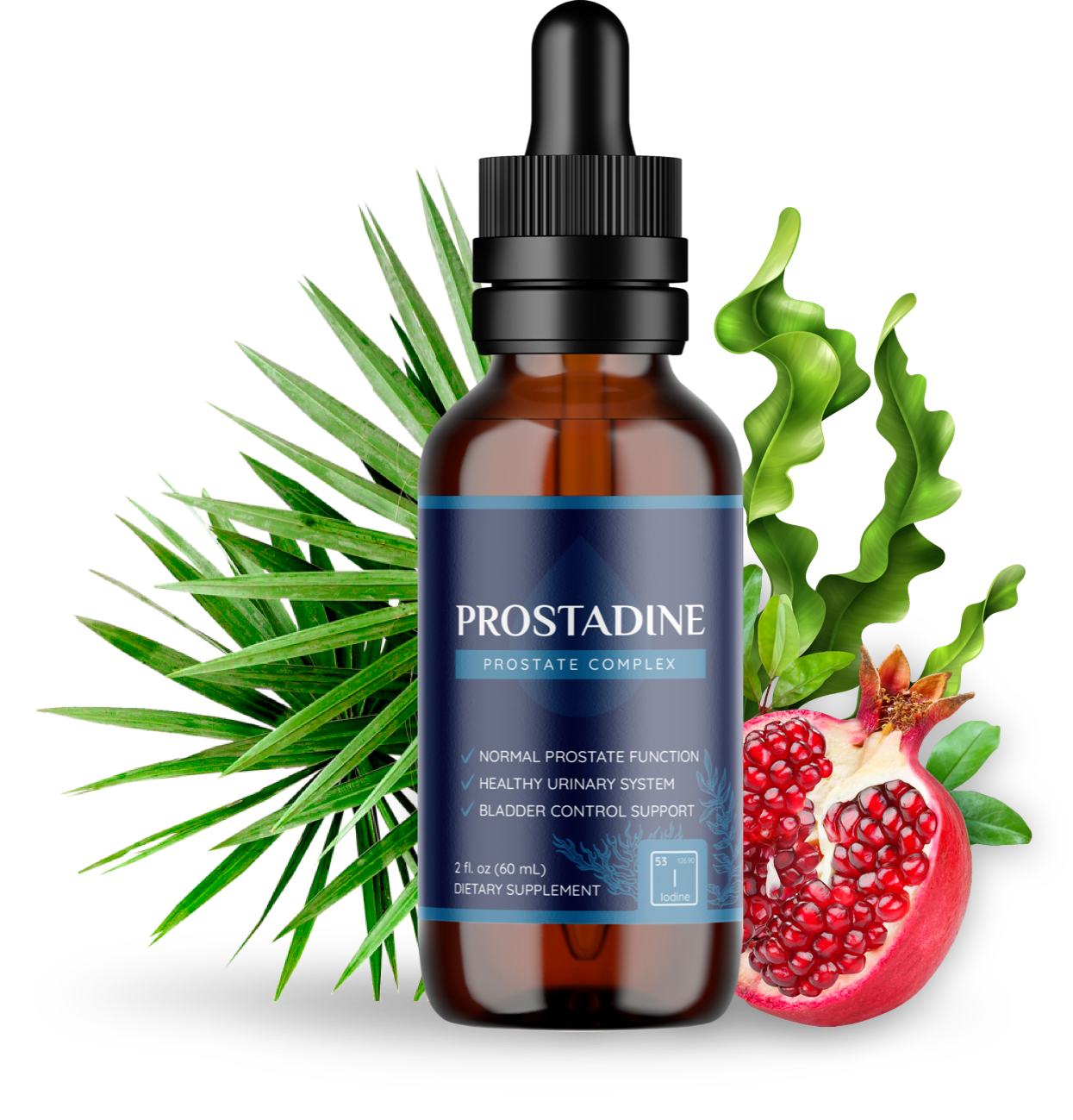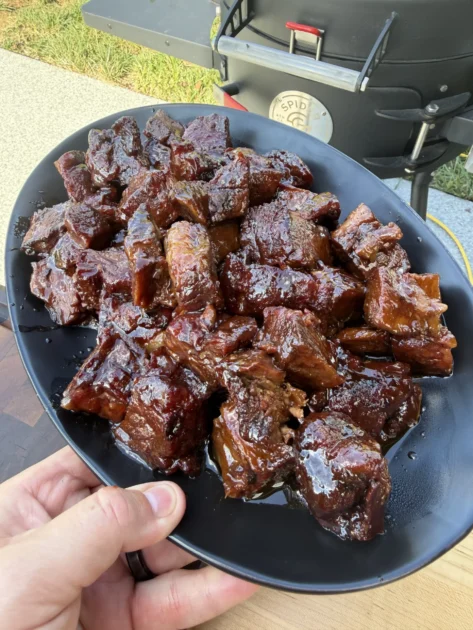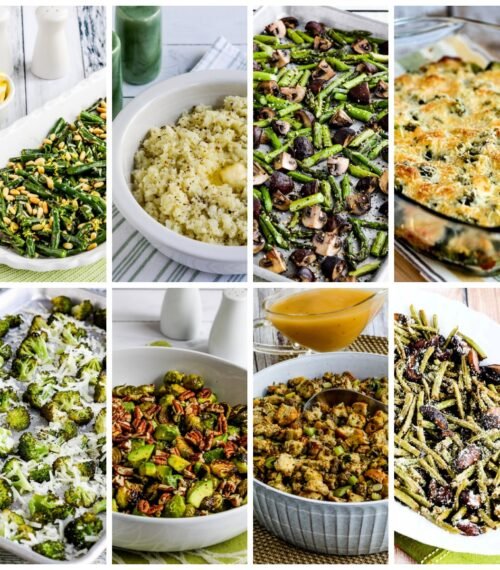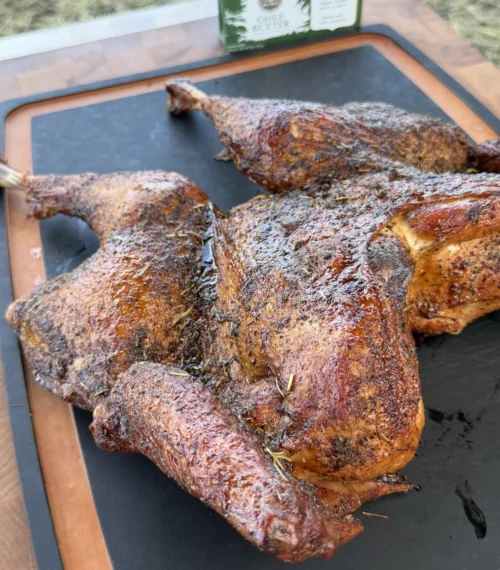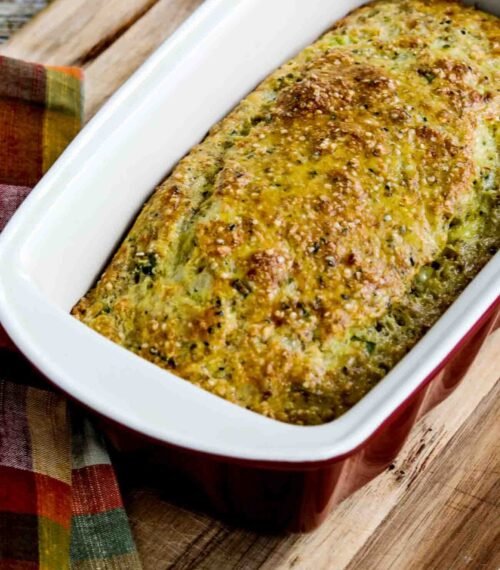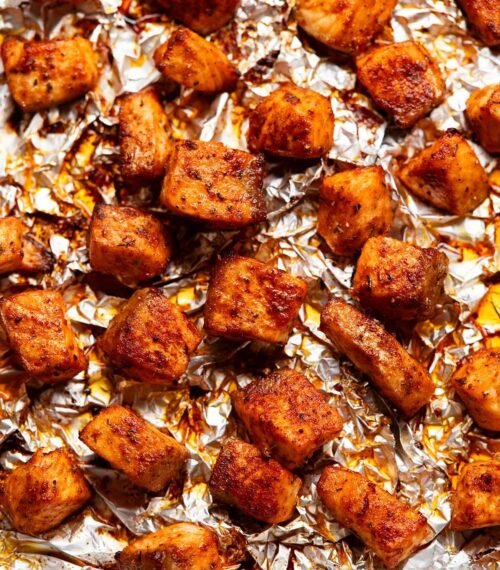Recipe Overview: Bourbon Maple Chuck Roast Burnt Ends Chuck roast cubes smoked until bark forms, braised until tender, then glazed with bourbon-maple sauce and caramelized into sticky BBQ candy
Prep Time: 30 min | Cook Time: 6 hrs | Total Time: 6.5 hrs | Servings: 6-8 | Calories: 430/serving
Bourbon maple chuck roast burnt ends deliver all the addictive qualities of traditional brisket burnt ends at a fraction of the cost and time commitment. These chuck roast burnt ends start as two-to-three-inch cubes of well-marbled beef shoulder smoked over hickory or oak until they develop a mahogany bark. The cubes then braise covered in beef broth until fork-tender at 195-200°F before getting tossed in a glossy bourbon-maple glaze. A final uncovered smoke caramelizes the sauce into a sticky coating that transforms each cube into bite-sized barbecue candy balancing smoke, sweet, and savory in every piece.
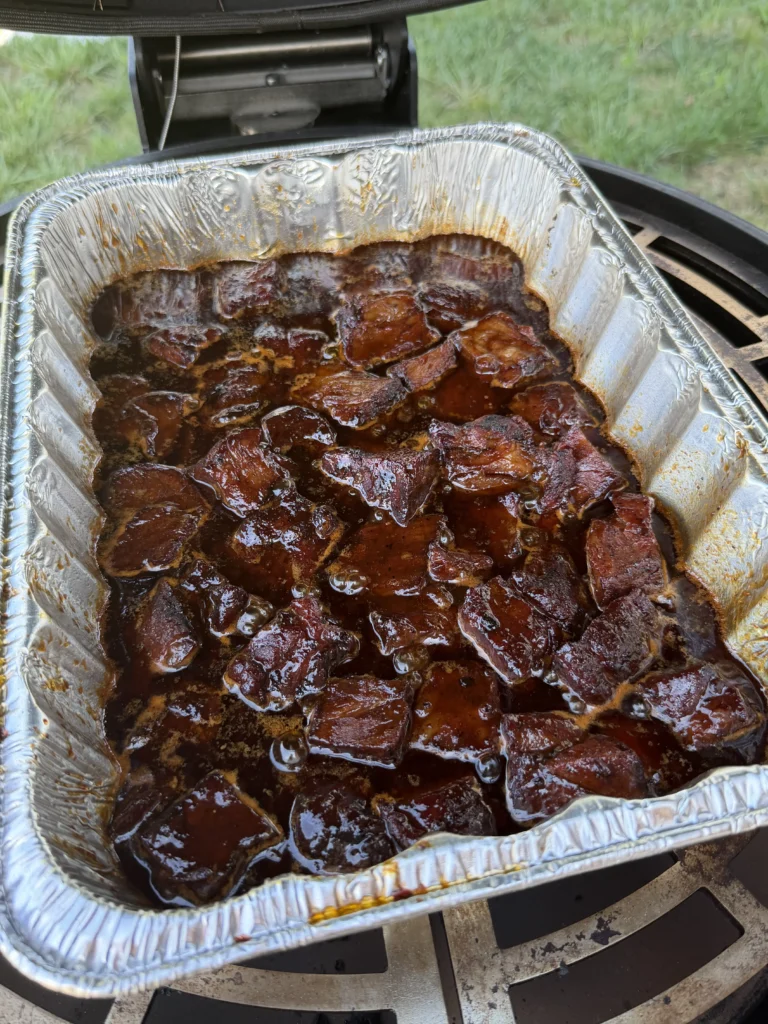
What makes this sweet bourbon maple burnt ends recipe special is how chuck roast’s abundant marbling and connective tissue create superior texture compared to leaner cuts. The intramuscular fat renders during the long smoke, keeping the meat incredibly juicy while the collagen breaks down into gelatin that gives each bite that signature fall-apart tenderness. The bourbon-maple glaze combines the caramel notes of aged whiskey with pure maple syrup’s natural sweetness, creating complexity that elevates these beyond simple BBQ sauce burnt ends.
This chuck roast burnt ends recipe works brilliantly for anyone who wants burnt ends without committing eight to twelve hours to a full brisket. Chuck roast cooks faster than brisket point while delivering comparable results at significantly lower cost per pound. The make-ahead friendly nature means you can smoke the cubes through the braising stage one day, then glaze and finish them just before serving. Whether you’re feeding a crowd for game day or creating viral-worthy barbecue content, these bourbon maple burnt ends consistently deliver impressive results that disappear fast.
Why Chuck Roast Makes Excellent Burnt Ends
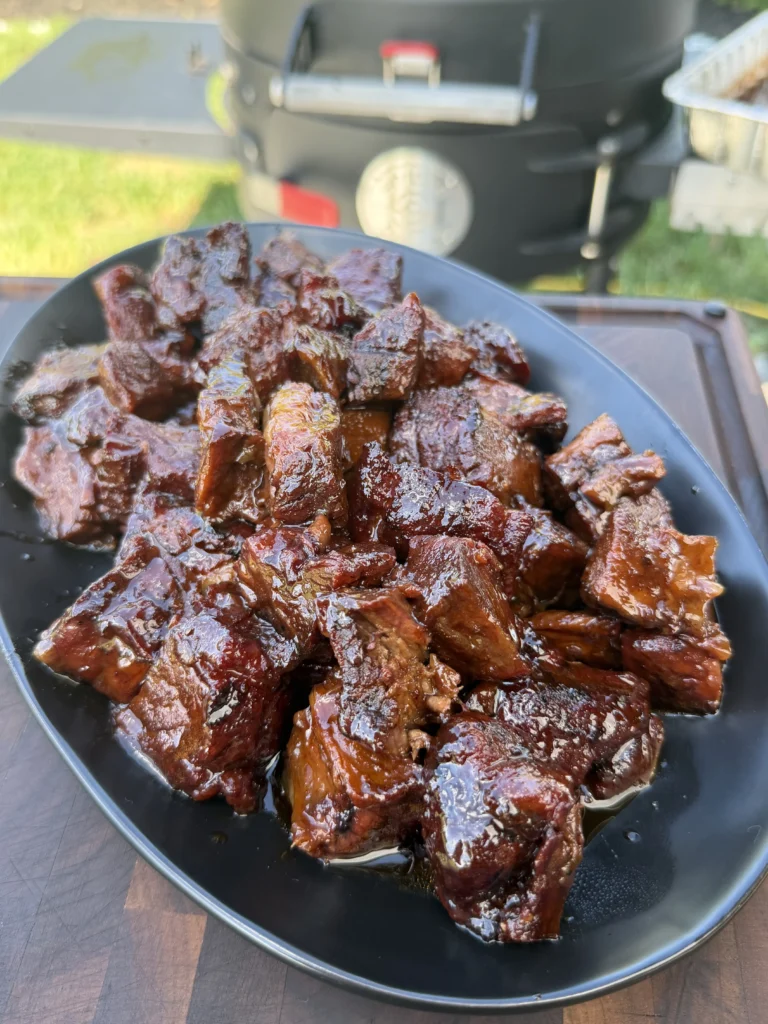
Chuck roast comes from the shoulder section of the cow, an area that gets significant exercise and develops strong connective tissue along with substantial marbling. This combination of fat and collagen is exactly what burnt ends need – the fat keeps everything moist during long cooking while the collagen breaks down into gelatin that creates tender, juicy texture. Chuck roast contains multiple muscle groups with varying grain directions, creating interesting textural complexity when cut into cubes.
The cut’s relatively low cost compared to brisket point makes it ideal for experimentation and large gatherings. You can buy four to five pounds of chuck roast for less than half what a whole brisket costs, making burnt ends an accessible treat rather than a special occasion splurge. The smaller starting weight also means less cooking time – six hours total versus the twelve-plus hours often required for brisket burnt ends.
Chuck roast’s irregular shape with thick and thin portions actually works to your advantage when cubing. The variation in size creates burnt ends with different levels of crust development and rendered fat, providing variety in each bite. Some pieces will be more bark-forward with crispy edges, while others will be extra tender and fatty. This diversity makes eating burnt ends more interesting than if every piece were identical.
The Three-Stage Smoking Method for Burnt Ends
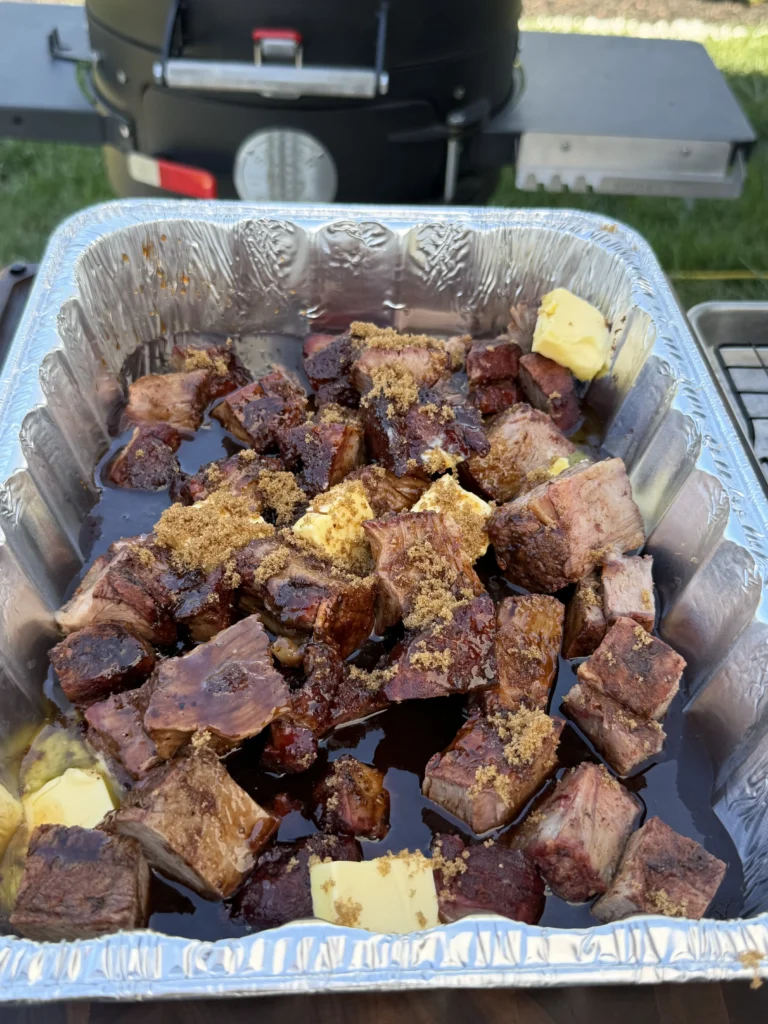
The burnt ends technique requires three distinct cooking stages that each serve specific purposes. The initial three-hour smoke develops bark while beginning to render fat and break down connective tissue. This stage is when the meat absorbs the most smoke flavor, as it’s most receptive when cold and moist. The dry heat creates the Maillard reaction that develops complex savory flavors while the sugars in the rub caramelize into a crust.
The covered braising stage from 165°F to 195-200°F is where chuck roast transforms from cooked but tough into fall-apart tender. During this two-hour covered cook, the sealed foil pan creates steam that gently finishes cooking the meat while the beef broth or bourbon adds moisture and prevents drying. The temperature range of 195-200°F is the sweet spot where collagen fully converts to gelatin without the meat turning mushy or falling apart completely.
The final glazing and caramelization stage uncovered for thirty to forty-five minutes is what separates good burnt ends from great ones. Removing the foil allows the bourbon-maple glaze to reduce and concentrate on each cube’s surface while the sugars caramelize in the dry heat. This creates that signature sticky, glossy coating that defines burnt ends. The brief uncovered cook also allows excess moisture to evaporate, ensuring the burnt ends are tacky rather than swimming in thin sauce.
Building the Bourbon Maple Glaze
The bourbon-maple glaze combines aged whiskey with pure maple syrup to create complexity beyond simple BBQ sauce. Bourbon contributes caramel, vanilla, and oak notes from barrel aging that add depth and sophistication. The alcohol cooks off during simmering, leaving behind the whiskey’s complex flavors without any harsh booze taste. You don’t need expensive bourbon – mid-shelf brands work perfectly since the other ingredients will round out the flavor.
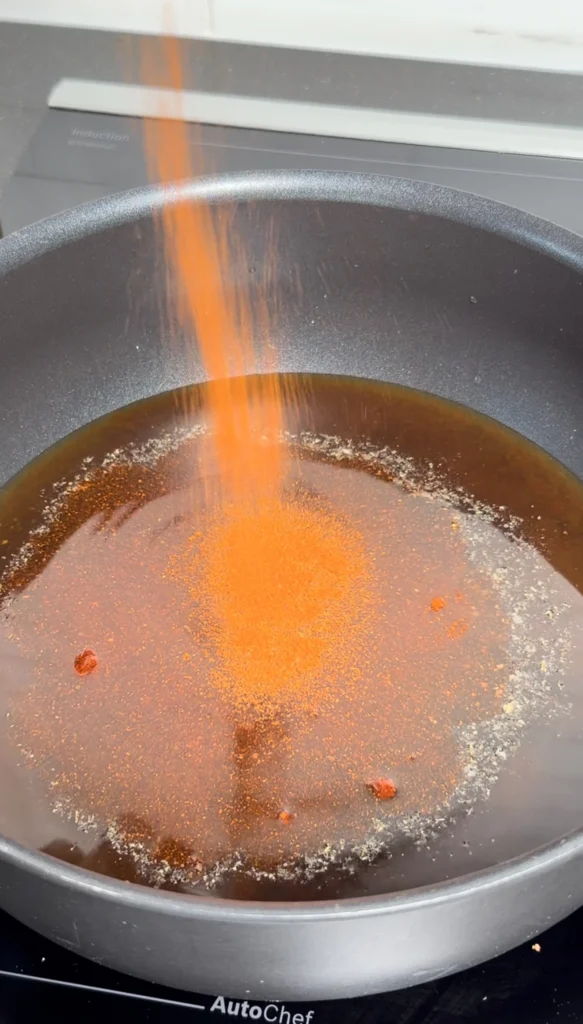
Pure maple syrup is essential rather than pancake syrup which contains corn syrup and artificial flavors. Real maple syrup provides natural sweetness with subtle woody, earthy notes that complement both the beef and bourbon. Grade A amber or dark amber maple syrup works best, offering more pronounced maple flavor than the lighter grades. The maple’s natural sugars also caramelize beautifully during the final glazing stage.
Brown sugar adds molasses depth that rounds out the glaze while contributing additional caramelization. The combination of maple syrup and brown sugar creates layered sweetness that’s more interesting than either ingredient alone. BBQ sauce provides the familiar tangy-sweet base along with tomato richness and spices. Using a smoky or sweet BBQ sauce works best – avoid vinegar-forward Carolina styles that would clash with the bourbon and maple.
Butter adds richness and helps emulsify the glaze, creating better coating on the meat. Apple cider vinegar provides acidity that balances all the sweet components while helping tenderize the meat’s surface. Smoked paprika reinforces the smoke from the wood while adding color and subtle heat. Together, these ingredients create a complex glaze that tastes like much more than the sum of its parts.
The Mustard Binder Technique
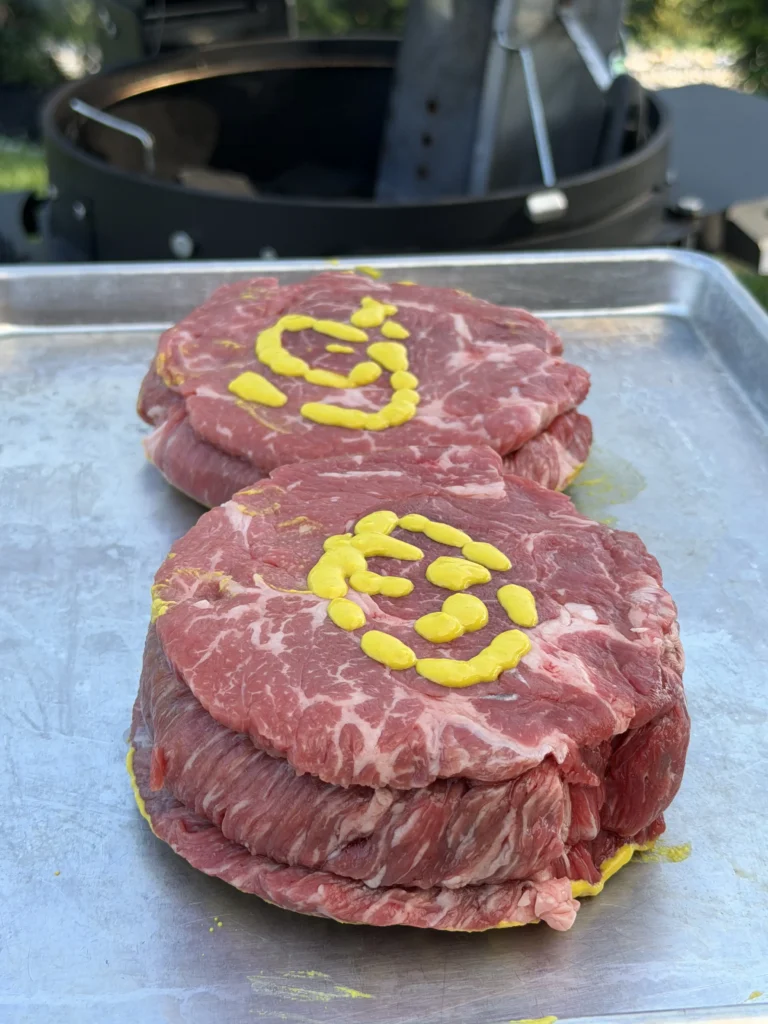
Yellow mustard serves as a binder that helps the BBQ rub adhere to the meat’s surface during the long smoke. The mustard’s moisture creates a sticky layer that seasoning clings to rather than falling off when you move the meat. Despite what you might expect, the mustard flavor doesn’t come through in the finished burnt ends – it simply helps hold the rub in place while adding no detectable taste.
The mustard also contains natural sugars and acids that contribute to bark development. As the mustard dries during smoking, it forms part of the crust along with the rub, creating better texture than rub applied to bare meat. The thin coating is all you need – you should be able to see the meat through the mustard layer. Too much creates a thick paste that interferes with smoke penetration.
Understanding Internal Temperature Targets
The temperature progression from 165°F to 195-200°F during braising represents the critical zone where chuck roast transforms from cooked but tough into tender burnt ends. At 165°F, the meat is fully cooked and safe to eat, but the connective tissue remains largely intact and the fat hasn’t fully rendered. This is why the cubes need the covered braising environment – they require gentle, moist heat to finish properly.
Between 165°F and 195°F, collagen steadily converts to gelatin while remaining fat pockets melt throughout the meat. The braising liquid creates steam that keeps everything moist while the sealed pan traps heat for even, gentle cooking. This transformation happens gradually rather than all at once, which is why you can’t rush this stage. Trying to speed it up with higher temperature would dry out the exterior before the interior tenderizes.
Pulling the burnt ends at 195-200°F ensures maximum tenderness while maintaining enough structure that the cubes don’t fall apart into shreds. Above 205°F, chuck roast can become so tender it loses its shape and turns into pulled beef rather than distinct burnt ends. The probe test is crucial – an instant-read thermometer should slide in and out with minimal resistance, like pushing into soft butter.
Ingredients
For the Beef:
Sweet Bourbon Maple Glaze:
For Braising:
Garnishes (optional):
Step-by-Step Instructions
Trim and Prepare the Whole Chuck Roasts
Remove the chuck roasts from refrigeration and place them on a large cutting board. Using a sharp knife, trim away any large pieces of exterior fat that are more than a quarter-inch thick, as excessive fat won’t render completely. Also remove any silver skin or tough membrane on the surface – these won’t break down during cooking and will create chewy spots. Leave the internal marbling intact, as this fat is what keeps the burnt ends juicy.
Pat the trimmed chuck roasts completely dry with paper towels. Any surface moisture will dilute the mustard binder and prevent the rub from adhering properly. Let the roasts sit at room temperature for about twenty to thirty minutes to take the chill off – this promotes more even cooking during the initial smoke.
Apply Mustard Binder and BBQ Rub to Whole Roasts
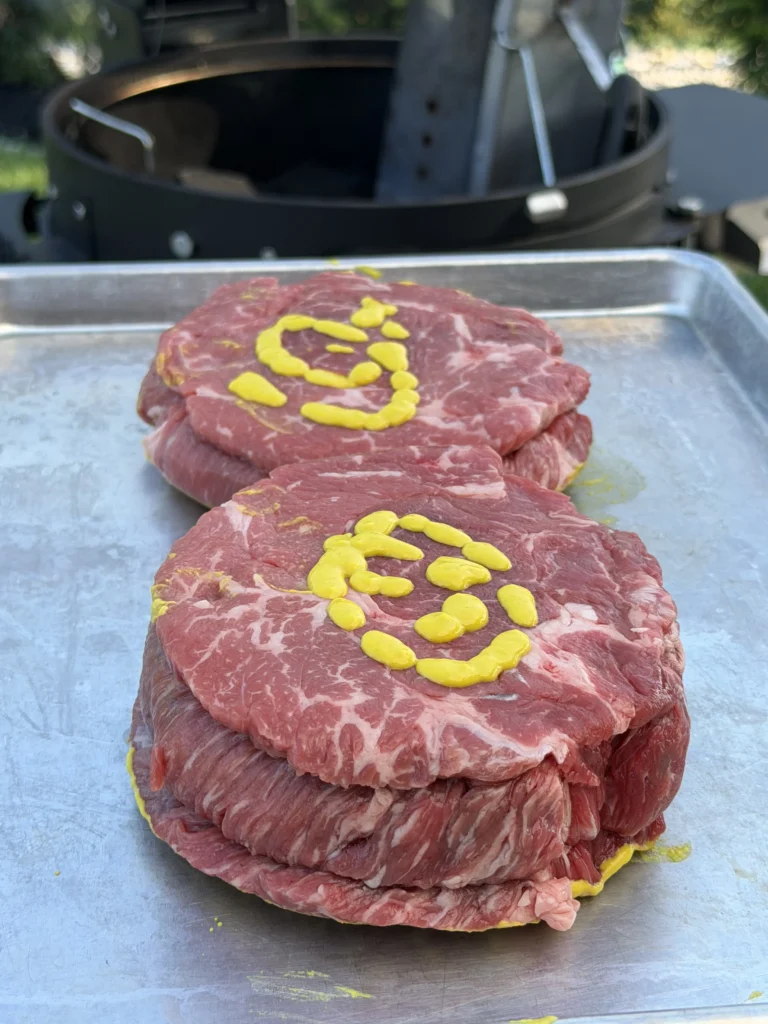
Using a basting brush or your hands, coat each whole chuck roast with a thin layer of yellow mustard on all surfaces. The coating should be thin enough that you can still see the beef through it – you’re creating a sticky surface for the rub, not making mustard-coated beef. The mustard will help the rub adhere during the long smoke while contributing to bark development without adding any detectable mustard flavor.
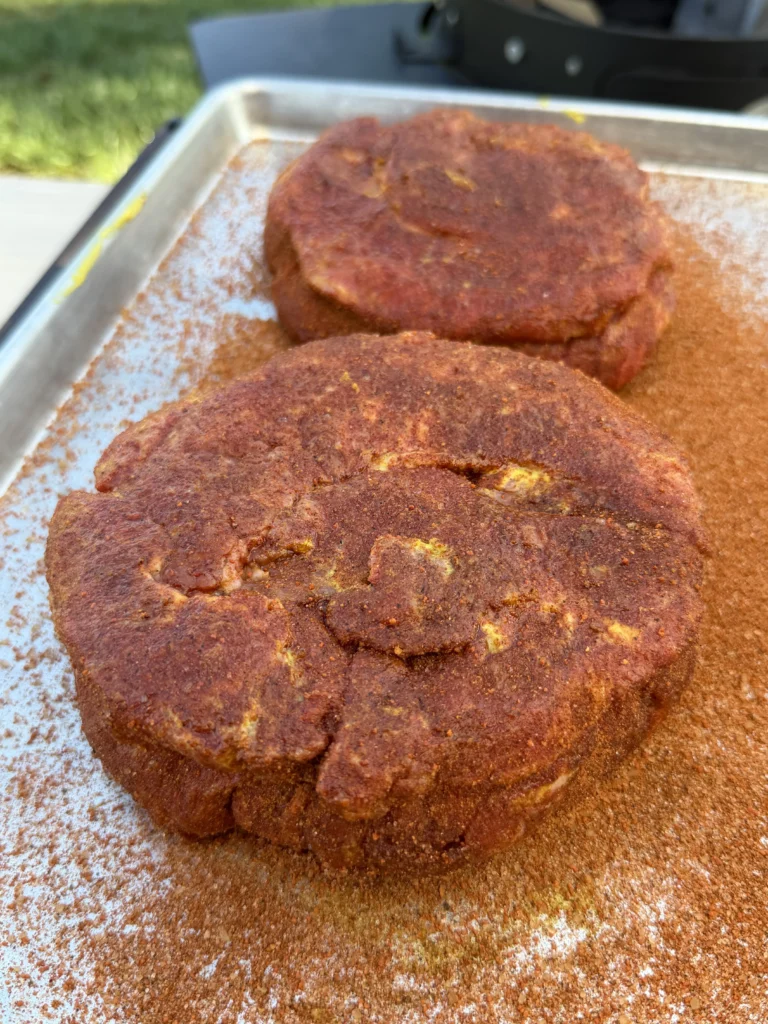
Sprinkle the BBQ rub generously over all surfaces of the mustard-coated roasts. Use a sweet and smoky style rub that will complement the bourbon-maple glaze. You’ll need about half a cup total for four to five pounds of chuck roast. Use your hands to press the rub into the meat, ensuring every surface gets well-coated with no bare spots. The seasoning should form a thick, visible crust over the entire exterior. Let the seasoned roasts sit while you prepare the smoker.
Preheat the Smoker
Load your smoker with hickory, oak, or pecan wood – all three provide strong smoke flavor that stands up to beef’s richness. Hickory is most traditional and provides bold, bacon-like smoke. Oak is slightly milder with clean smoke character. Pecan adds nutty sweetness that complements the maple glaze. Preheat the smoker to 250°F with the lid closed, allowing it to come to stable temperature and produce clean, thin blue smoke.
Make sure you have enough fuel for approximately six hours of total cooking time. Clean the grill grates with a brush and lightly oil them to prevent sticking, though chuck roast’s fat content means sticking is rarely an issue. Have your instant-read thermometer ready for checking temperatures later.
Smoke the Whole Chuck Roasts Until Bark Forms
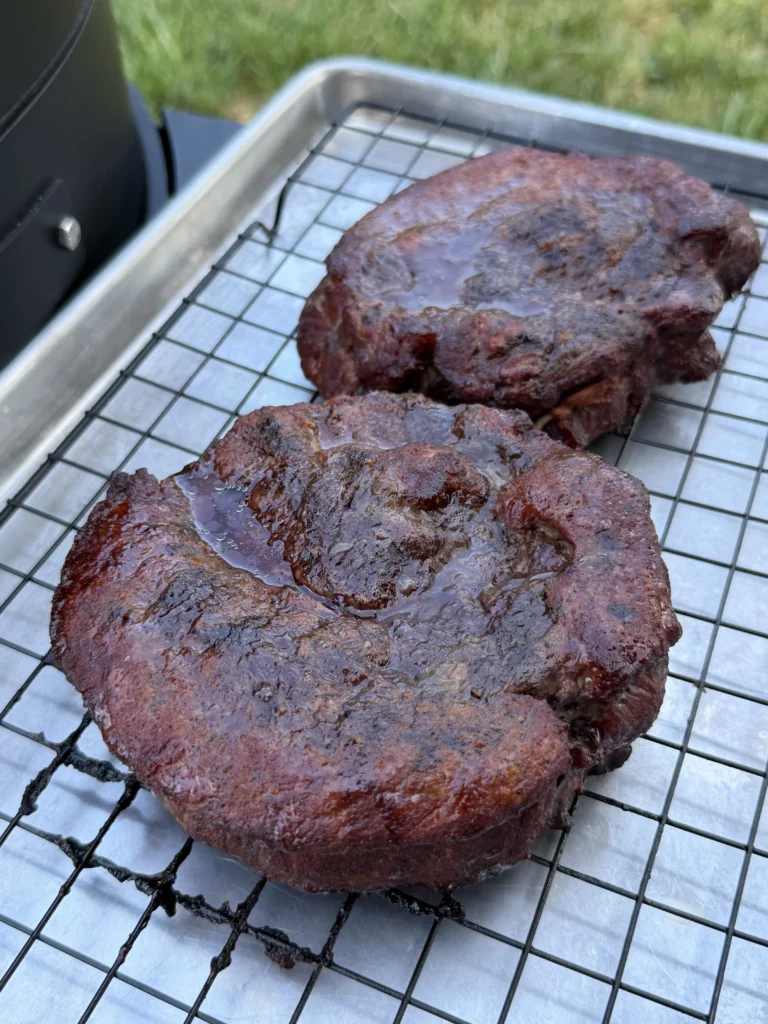
Once the smoker reaches 250°F and is producing clean smoke, place the seasoned chuck roasts directly on the grill grates. Position them with some space between them for smoke circulation. Close the smoker lid and smoke undisturbed for the first hour – resist the urge to peek, as opening the lid releases heat and smoke, extending cooking time.
After the first hour, you can check occasionally to monitor bark development and ensure the smoker is maintaining 250°F. Add more fuel as needed for consistent temperature. Continue smoking for approximately three hours total, or until the roasts reach about 165°F internal temperature when checked in the thickest part with an instant-read thermometer. The exterior should have developed a nice mahogany bark – dark, crusty, and aromatic with the seasoning caramelized into a flavorful crust.
The bark is crucial because it provides the texture and concentrated flavor that defines burnt ends. Don’t rush this stage – proper bark development takes time. If the bark isn’t forming well after two and a half hours, you can increase temperature slightly to 275°F, but patience is key. The roasts should feel firm on the outside with some give when pressed.
Remove and Cut into Cubes
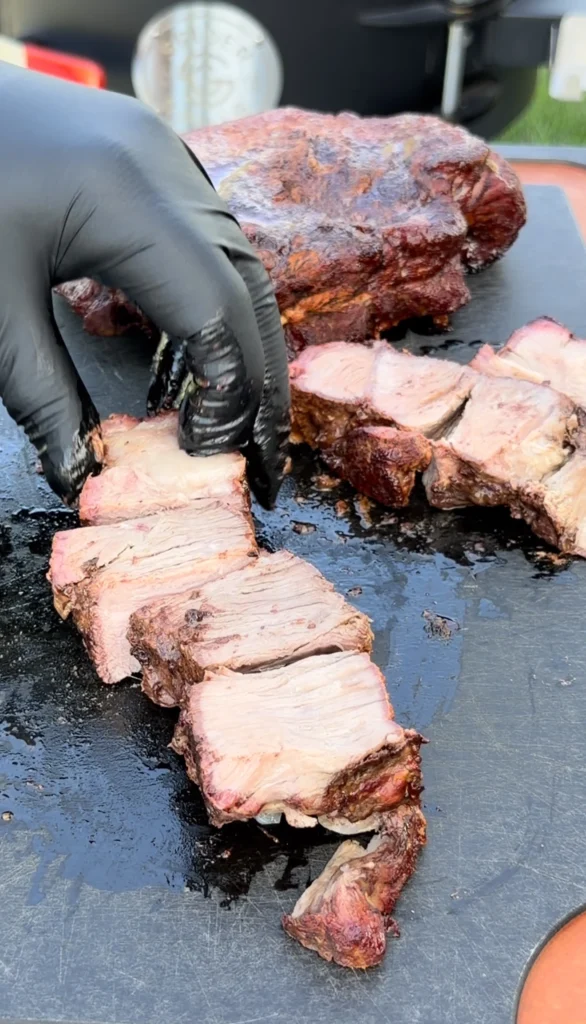
Once the chuck roasts reach approximately 165°F internal temperature and have developed good bark all over, carefully remove them from the smoker and place them on a large cutting board. At this temperature, the meat is firm enough to cut cleanly but has already begun tenderizing. Let them rest for just five minutes to make handling easier – you don’t need a full rest since they’re going back for more cooking.
Using a sharp chef’s knife, cut the smoked chuck roasts into large cubes approximately two to three inches on each side. Work methodically to create relatively uniform pieces, though some variation is fine and actually creates textural interest. The cubes will shrink during braising as fat renders and moisture evaporates, so err on the larger side. The bark-coated exterior will now be distributed across all the cubes – every piece should have some of that flavorful crust on it.
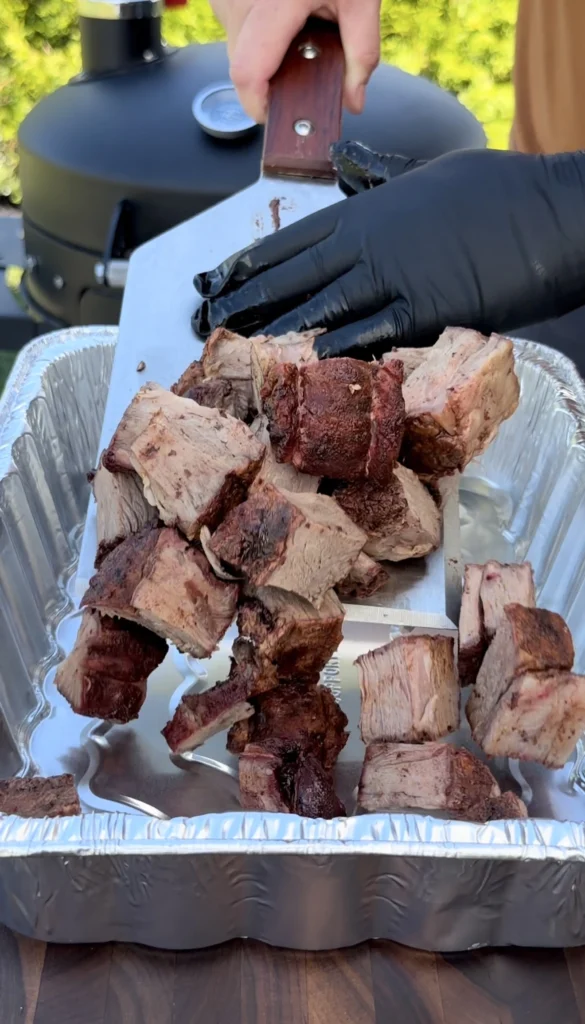
As you cut, you’ll notice how the smoke ring has penetrated the meat and the bark has formed a beautiful crust. Don’t worry if some bark falls off during cutting – that’s normal and adds to the texture. You should get approximately twenty to twenty-five cubes from four to five pounds of smoked chuck roast. Transfer all the cubed meat to a disposable aluminum foil pan deep enough to hold them in a relatively even layer.
Braise the Cubes Until Fork-Tender
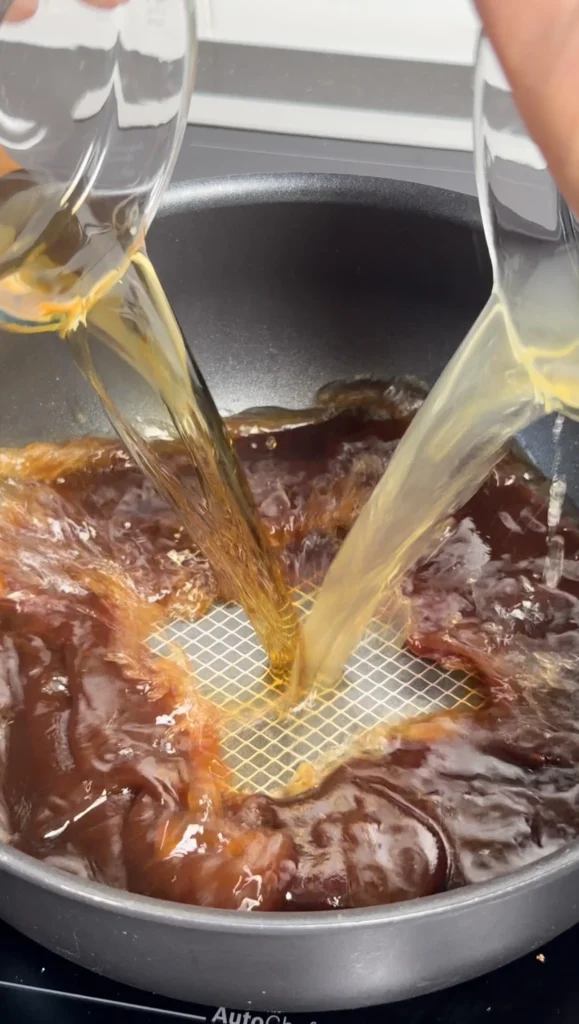
Pour half a cup of beef broth over the cubed smoked chuck roast in the foil pan. The liquid creates steam during braising that keeps everything moist while adding savory depth. For extra bourbon flavor, you can use a splash of bourbon instead of or in addition to the beef broth. The liquid should pool in the bottom of the pan around the cubes but not cover them – you’re creating a steaming environment, not boiling the meat.
Cover the entire pan tightly with heavy-duty aluminum foil, crimping it securely around all edges to create a complete seal. The sealed pan creates a braising environment where the cubes cook in moist heat. Place the covered pan back on the smoker at 250°F and close the lid. Continue cooking for approximately two more hours, or until the internal temperature of the cubes reaches 195-200°F.
After about ninety minutes, carefully remove the foil to check progress – watch for escaping steam that will be very hot. Insert an instant-read thermometer into several cubes from different areas of the pan to verify temperature. More importantly, probe them – the thermometer should slide in and out with almost no resistance, like pushing into soft butter. If the cubes still feel firm or the thermometer meets resistance, re-cover and continue cooking, checking every twenty to thirty minutes. The braising stage can take anywhere from ninety minutes to two and a half hours depending on cube size and smoker efficiency.
Make the Bourbon Maple Glaze
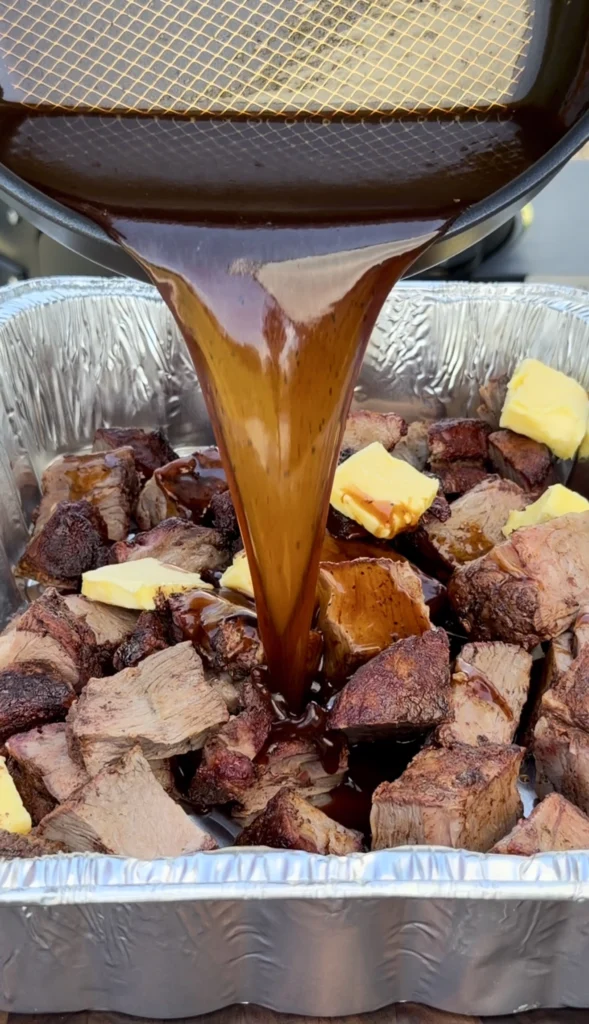
While the burnt ends braise, prepare the bourbon-maple glaze. In a medium saucepan, combine the bourbon, pure maple syrup, brown sugar, BBQ sauce, unsalted butter, apple cider vinegar, and smoked paprika if using. Place the saucepan over medium heat and whisk everything together until the butter melts and the brown sugar dissolves completely.
Once the mixture is uniform and simmering, reduce heat to medium-low and continue cooking for ten to fifteen minutes, stirring occasionally. The glaze will thicken noticeably as it reduces and the sugars concentrate. You want it thick enough to coat the back of a spoon but still pourable – like warm honey consistency. If it gets too thick, add a tablespoon of water or bourbon to thin it slightly.
Taste and adjust the glaze – it should be sweet with noticeable bourbon depth, bright tang from the vinegar, and subtle smoke from the paprika. The flavor should be bold since it needs to stand up to the intensely smoky beef. Remove from heat and set aside until the burnt ends are ready. The glaze can be made up to a week ahead and refrigerated, then gently reheated before using.
Glaze and Caramelize the Burnt Ends
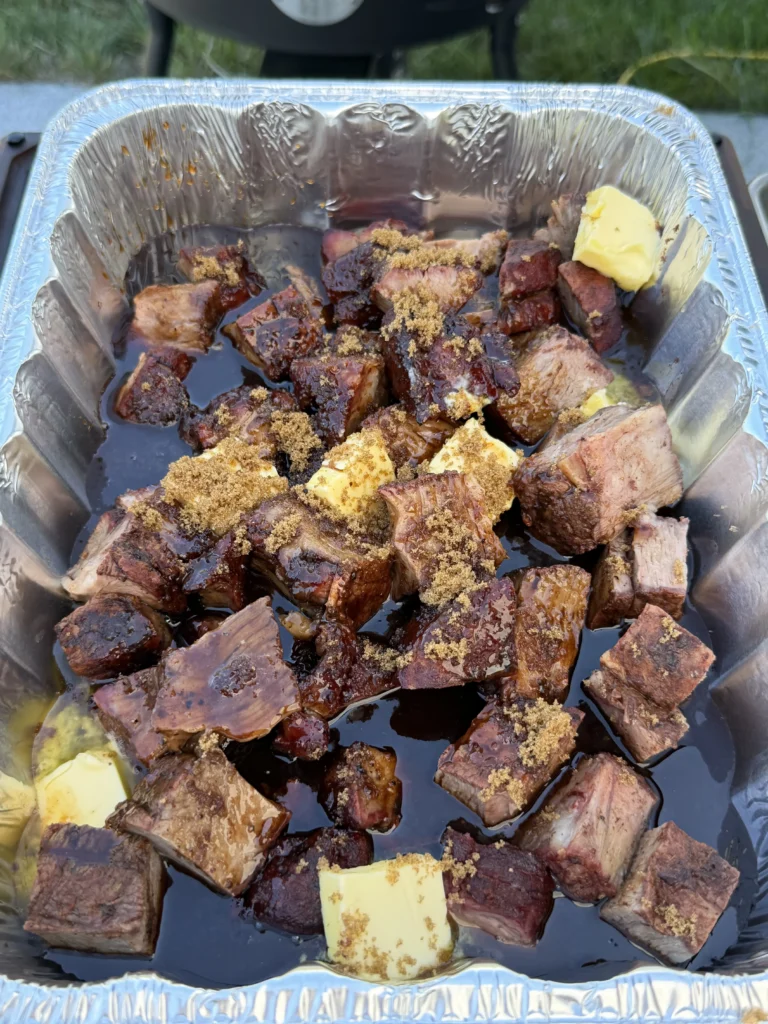
Once the burnt ends reach 195-200°F internal temperature and probe fork-tender, remove the foil covering completely. The cubes should be very tender and dark, sitting in accumulated juices and rendered fat. The bark that was on the exterior before cutting should now be distributed throughout the pan, coating various surfaces of the cubes.
Carefully drain most of the liquid from the pan, leaving just a thin layer at the bottom. Tilt the pan and use a ladle or large spoon to remove excess liquid – you can save this flavorful braising liquid for adding to baked beans or other sides if desired. Draining is important because you want the glaze to coat the meat, not be diluted by excess liquid.
Pour the prepared bourbon-maple glaze over the tender burnt ends. Use a large spoon or heat-resistant spatula to gently toss the cubes, coating every piece thoroughly with the sticky glaze. The hot beef will help the glaze flow and coat evenly. Work carefully to avoid breaking apart the tender cubes. Every piece should be glistening with the glossy bourbon-maple sauce.
Place the uncovered pan back on the smoker at 250°F. Smoke uncovered for thirty to forty-five minutes, stirring and gently tossing the burnt ends every ten to fifteen minutes to ensure even glaze coverage and caramelization. Watch them carefully during this stage – you want the glaze to reduce and become sticky, with the sugars caramelizing into a glossy coating that looks almost lacquered.
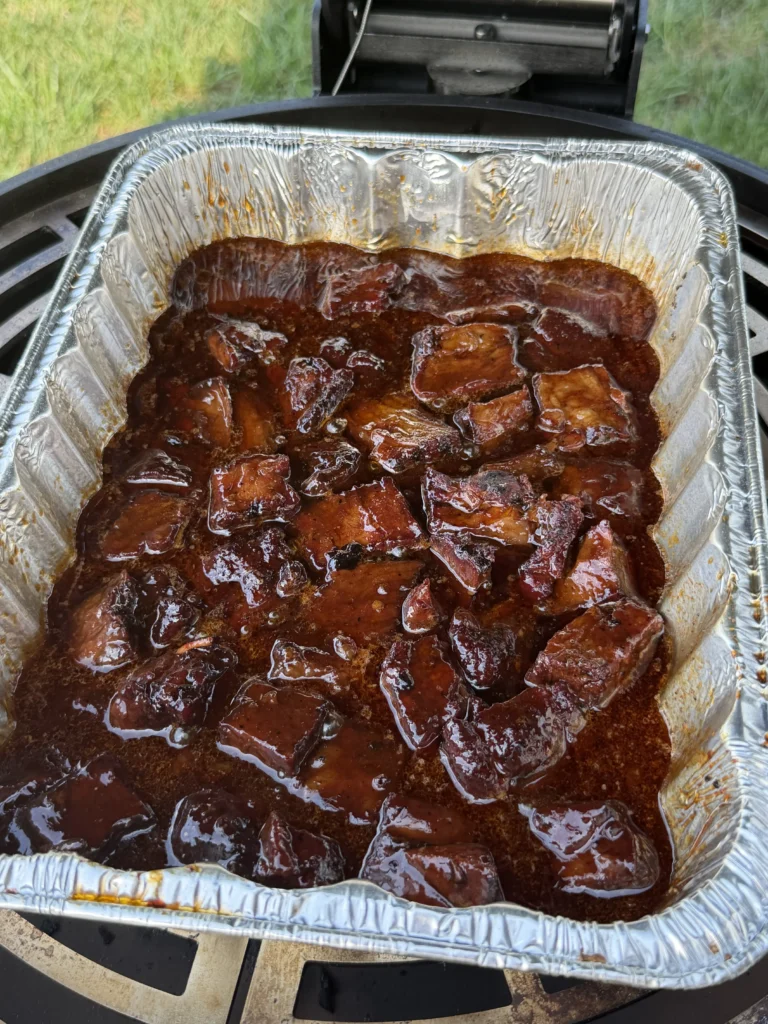
The burnt ends should develop a shiny, deeply colored appearance with the sauce becoming progressively thicker and more caramelized with each stir. If they start to get too dark or the glaze begins to burn, remove immediately. The final product should be deeply mahogany-colored and very sticky, with each cube coated in thick, caramelized sauce that’s tacky to the touch but not burnt.
Rest and Serve
Remove the pan from the smoker and let the burnt ends rest uncovered for ten minutes. This brief rest allows the glaze to set slightly into that perfect sticky texture while the meat relaxes. The coating will firm up just enough to create the ideal balance between liquid and solid – sticky enough to coat your fingers but not so thick it hardens.
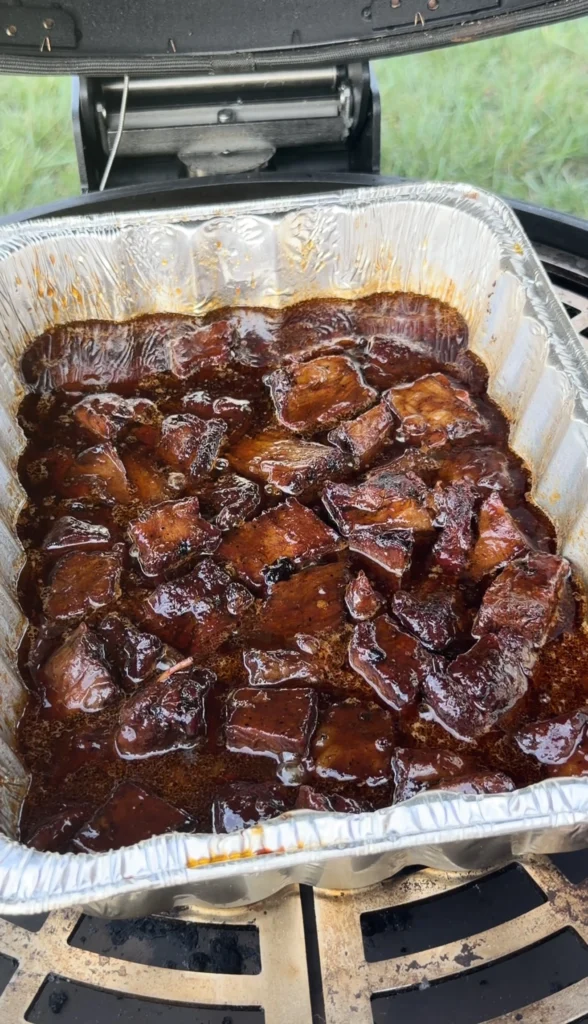
Transfer the bourbon maple burnt ends to a serving platter or keep them in the foil pan for rustic presentation. Garnish with freshly chopped parsley or chives for a pop of color and fresh flavor contrast. A sprinkle of flaky sea salt adds visual appeal and a touch of crunch that enhances the sweet glaze.
Serve immediately with toothpicks for easy eating as finger food, pile them on slider buns for mini sandwiches, or serve them over creamy mac and cheese where they become the star protein. Each bite should deliver tender, juicy beef with a smoky bark coating and sticky-sweet bourbon-maple glaze that balances smoke, sweet, savory, and rich beef flavor. Any leftovers can be refrigerated in an airtight container for up to four days and reheated gently in a 300°F oven or smoker with a splash of extra glaze to refresh the coating.eef with a sticky-sweet bourbon-maple coating and lingering smoke flavor. Any leftovers can be refrigerated in an airtight container for up to four days and reheated gently with a splash of extra glaze.
FAQ
Can I make these in the oven instead of a smoker?
Yes, though you’ll lose the smoke flavor that defines burnt ends. Roast the seasoned cubes uncovered on a wire rack over a baking sheet at 250°F for about three hours until they reach 165°F and develop some crust. Transfer to a covered pan with broth and continue cooking at 250°F until they reach 195-200°F. Glaze and finish under the broiler for caramelization, watching carefully to prevent burning.
What wood is best for chuck roast burnt ends?
Hickory and oak are classic choices that provide strong smoke flavor that complements beef. Hickory is boldest with bacon-like notes, while oak is slightly milder with clean smoke. Pecan adds nutty sweetness that pairs beautifully with the maple glaze. Cherry wood works too, providing fruity undertones. Avoid mesquite which can become bitter during long cooks.
Can I use brisket point instead of chuck roast?
Absolutely – brisket point is the traditional cut for burnt ends and will work beautifully. Brisket takes longer to reach tenderness, typically seven to eight hours total versus six for chuck roast. The technique remains identical, just adjust timing. Brisket also costs significantly more, which is why chuck roast is a practical alternative.
Can I make the burnt ends ahead of time?
Yes, burnt ends are very make-ahead friendly. You can smoke through the braising stage (until 195-200°F), then refrigerate for up to two days. When ready to serve, reheat in a 275°F smoker or oven with the glaze, allowing thirty to forty-five minutes for the sauce to caramelize. They’ll be nearly as good as fresh. You can also freeze fully cooked burnt ends for up to three months.
What if I don’t drink alcohol – can I skip the bourbon? Yes, substitute apple juice plus one teaspoon of vanilla extract for non-alcoholic alternative that mimics bourbon’s sweet, caramel notes. The glaze will still be delicious, just without the complex depth that aged whiskey provides. Remember that the alcohol cooks off during simmering, leaving only flavor behind, so the finished burnt ends contain minimal alcohol.
Conclusion
Bourbon maple chuck roast burnt ends prove that you don’t need a full brisket to create spectacular burnt ends that deliver all the smoky, sweet, sticky goodness that makes this dish so beloved. Chuck roast’s abundant marbling and connective tissue create tender, juicy results while costing significantly less than brisket point. The three-stage cooking method ensures proper bark development, complete fat rendering, and that signature sticky glaze that transforms cubed beef into barbecue candy.
What makes this sweet bourbon maple burnt ends recipe so successful is how the glaze combines aged whiskey’s complexity with pure maple syrup’s natural sweetness and BBQ sauce’s familiar tang. The bourbon and maple create sophisticated depth that elevates these beyond simple sauce-tossed meat cubes. The final caramelization stage is crucial – it’s what transforms good burnt ends into great ones by concentrating the glaze into that glossy, sticky coating.
These chuck roast burnt ends work beautifully for game day gatherings, backyard barbecues, or any time you want impressive food that feeds a crowd without the time and cost commitment of whole brisket. The make-ahead friendly nature means you can prep everything in advance and just do the final glazing before serving. Master this recipe and you’ll have a signature dish that combines traditional barbecue technique with bold bourbon-maple flavors that keep people coming back for more.
If you’re looking for more recipes , click the link! Check out all of our grilling recipes here for more steak, seafood, and BBQ favorites that are perfect for your next cookout.
COMMON ITEMS USED IN THESE RECIPES
The Huntsman Grill
Knitted Gloves
Food Processor
Cast Iron Skillet
Meater +
Upgrade Your Meat Game with Grill Nation x Linz Heritage Angus
If you really want to take your grilling and cooking to the next level, you need to check out our collaboration with Linz Heritage Angus. We’ve partnered with them to bring you some of the best beef you can get your hands on.
Linz Heritage Angus isn’t your typical grocery store meat. These guys are the real deal – they raise their cattle the right way, and you can taste the difference in every bite. We’re talking about beef that’s been dry-aged to perfection, with marbling that makes your mouth water just looking at it.
Check out these premium cuts that’ll change how you think about beef:
Premium Ribeye Steaks – Perfect for special occasions
Dry-Aged Beef Selection – Take your grilling to the next level
Ground Beef & Burger Blends – The foundation of great BBQ
Use code GN15 at checkout for 15% off your first order. Trust me, once you try Linz Heritage Angus, you’ll never want to go back to regular store-bought beef.














































